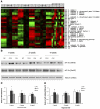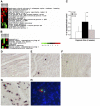Gene expression and phenotypic characterization of mouse heart after chronic constant or intermittent hypoxia
- PMID: 15928208
- PMCID: PMC2856928
- DOI: 10.1152/physiolgenomics.00217.2004
Gene expression and phenotypic characterization of mouse heart after chronic constant or intermittent hypoxia
Abstract
Chronic constant hypoxia (CCH), such as in pulmonary diseases or high altitude, and chronic intermittent hypoxia (CIH), such as in sleep apnea, can lead to major changes in the heart. Molecular mechanisms underlying these cardiac alterations are not well understood. We hypothesized that changes in gene expression could help to delineate such mechanisms. The current study used a neonatal mouse model in CCH or CIH combined with cDNA microarrays to determine changes in gene expression in the CCH or CIH mouse heart. Both CCH and CIH induced substantial alterations in gene expression. In addition, a robust right ventricular hypertrophy and cardiac enlargement was found in CCH- but not in CIH-treated mouse heart. On one hand, upregulation in RNA and protein levels of eukaryotic translation initiation factor-2alpha and -4E (eIF-2alpha and eIF-4E) was found in CCH, whereas eIF-4E was downregulated in 1- and 2-wk CIH, suggesting that eIF-4E is likely to play an important role in the cardiac hypertrophy observed in CCH-treated mice. On the other hand, the specific downregulation of heart development-related genes (e.g., notch gene homolog-1, MAD homolog-4) and the upregulation of proteolysis genes (e.g., calpain-5) in the CIH heart can explain the lack of hypertrophy in CIH. Interestingly, apoptosis was enhanced in CCH but not CIH, and this was correlated with an upregulation of proapoptotic genes and downregulation of anti-apoptotic genes in CCH. In summary, our results indicate that 1) the pattern of gene response to CCH is different from that of CIH in mouse heart, and 2) the identified expression differences in certain gene groups are helpful in dissecting mechanisms responsible for phenotypes observed.
Figures







Similar articles
-
The Na+/Ca2+ exchanger-1 mediates left ventricular dysfunction in mice with chronic intermittent hypoxia.J Appl Physiol (1985). 2010 Dec;109(6):1675-85. doi: 10.1152/japplphysiol.01372.2009. Epub 2010 Oct 14. J Appl Physiol (1985). 2010. PMID: 20947716 Free PMC article.
-
Integrated transcriptomic response to cardiac chronic hypoxia: translation regulators and response to stress in cell survival.Funct Integr Genomics. 2008 Aug;8(3):265-75. doi: 10.1007/s10142-008-0082-y. Epub 2008 May 1. Funct Integr Genomics. 2008. PMID: 18446526 Free PMC article.
-
Gene expression in mouse brain following chronic hypoxia: role of sarcospan in glial cell death.Physiol Genomics. 2008 Feb 19;32(3):370-9. doi: 10.1152/physiolgenomics.00147.2007. Epub 2007 Dec 4. Physiol Genomics. 2008. PMID: 18056785
-
Left ventricular dysfunction and associated cellular injury in rats exposed to chronic intermittent hypoxia.J Appl Physiol (1985). 2008 Jan;104(1):218-23. doi: 10.1152/japplphysiol.00301.2007. Epub 2007 Nov 15. J Appl Physiol (1985). 2008. PMID: 18006871
-
Differential effects of chronic intermittent and chronic constant hypoxia on postnatal growth and development.Pediatr Pulmonol. 2008 Jan;43(1):20-8. doi: 10.1002/ppul.20729. Pediatr Pulmonol. 2008. PMID: 18041750
Cited by
-
Roxadustat as treatment for a blood transfusion-dependent maintenance hemodialysis patient: A case report and review of literature.World J Clin Cases. 2021 May 26;9(15):3680-3688. doi: 10.12998/wjcc.v9.i15.3680. World J Clin Cases. 2021. PMID: 34046470 Free PMC article.
-
Calpain chronicle--an enzyme family under multidisciplinary characterization.Proc Jpn Acad Ser B Phys Biol Sci. 2011;87(6):287-327. doi: 10.2183/pjab.87.287. Proc Jpn Acad Ser B Phys Biol Sci. 2011. PMID: 21670566 Free PMC article. Review.
-
Microbiota Modulates Cardiac Transcriptional Responses to Intermittent Hypoxia and Hypercapnia.Front Physiol. 2021 Jun 25;12:680275. doi: 10.3389/fphys.2021.680275. eCollection 2021. Front Physiol. 2021. PMID: 34248668 Free PMC article.
-
Reactive oxygen species and the brain in sleep apnea.Respir Physiol Neurobiol. 2010 Dec 31;174(3):307-16. doi: 10.1016/j.resp.2010.09.001. Epub 2010 Sep 15. Respir Physiol Neurobiol. 2010. PMID: 20833273 Free PMC article. Review.
-
Mice deficient in Mkp-1 develop more severe pulmonary hypertension and greater lung protein levels of arginase in response to chronic hypoxia.Am J Physiol Heart Circ Physiol. 2010 May;298(5):H1518-28. doi: 10.1152/ajpheart.00813.2009. Epub 2010 Feb 19. Am J Physiol Heart Circ Physiol. 2010. PMID: 20173047 Free PMC article.
References
-
- Arsham AM, Howell JJ, Simon MC. A novel hypoxia-inducible factor-independent hypoxic response regulating mammalian target of rapamycin and its targets. J Biol Chem. 2003;278:29655–29660. - PubMed
-
- Ashburner M, Ball CA, Blake JA, Botstein D, Butler H, Cherry JM, Davis AP, Dolinski K, Dwight SS, Eppig JT, Harris MA, Hill DP, Issel-Tarver L, Kasarskis A, Lewis S, Matese JC, Richardson JE, Ringwald M, Rubin GM, Sherlock G. Gene Ontology: tool for the unification of biology. Nat Genet. 2000;25:25–29. - PMC - PubMed
-
- Dahlquist KD, Salomonis N, Vranizan K, Lawlor SC, Conklin BR. GenMAPP, a new tool for viewing and analyzing microarray data on biological pathways. Nat Genet. 2002;31:19–20. - PubMed
Publication types
MeSH terms
Substances
Grants and funding
LinkOut - more resources
Full Text Sources
Molecular Biology Databases

